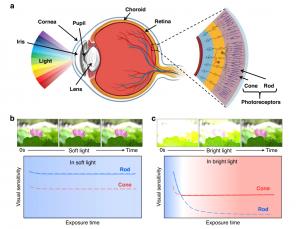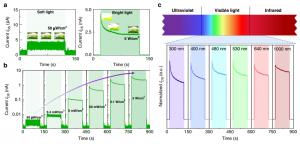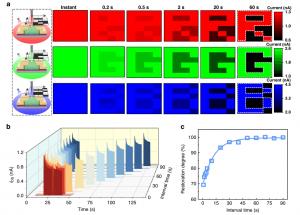Self-powered and Broadband Opto-sensor with Bionic Visual Adaptation Function
FAYETTEVILLE, GA, USA, August 16, 2023/EINPresswire.com/ -- A single two-terminal self-powered and broadband opto-sensor based on multilayer γ-InSe flakes was developed and exhibits good human-eye-like adaptation behaviors, including broadband light-sensing image adaptation (from ultraviolet to near-infrared), near-complete photosensitivity recovery (99.6%), and synergetic visual adaptation. Our studies not only could enrich the working mechanism of simulating human visual adaptation, but also may motivate the further development of advanced opto-sensors and artificial visual systems.
Recently, an artificial visual device with integrated visual adaptation functions was proposed by Professor Xu Haiyang's group from Key Laboratory of UV-Emitting Materials and Technology of Ministry of Education, Northeast Normal University, China. The device can operate in self-powered mode and exhibit good human-eye-like adaptation behaviors, which include broadband light-sensing image adaptation (from ultraviolet to near-infrared), near-complete photosensitivity recovery (99.6%), and synergetic visual adaptation, encouraging the advancement of intelligent opto-sensors and machine vision systems.
Visual perception, a vital sensing functionality for human beings and other vertebrates, contributes more than 80% of the perceptual information from the ambient environments to the brain. With the rapid development of artificial intelligence, artificial visual systems are demanded to be able to mimic the visual perception capabilities of biological systems. Among them, an important functionality is visual adaptation, which can automatically adjust the response to stimuli according to different light environments.
However, the existing efforts on mimicking visual adaptation functions have been trapped in complicated hardware and algorithms that typically reduce operating efficiency. Ideally, a new generation of artificial visual systems with adaptation functions should have a simpler structure and lesser logic operations. Unfortunately, their main mechanisms are still restricted to modulation of carrier trapping or ion migration, which are inadequate for the future development of visual adaptive devices and artificial visual systems. Hence, it is highly desired to explore more working mechanisms to serve the visual adaptation function of artificial visual systems that possess simple device architectures.
In this work, a two-terminal opto-sensor based on γ-InSe flake is experimentally demonstrated to emulate the human visual adaptation. The main working mechanism for the dynamic adaptation is confirmed to be the synergy of photo-pyroelectric effect and photo-thermoelectric effect. Because the γ-InSe opto-sensor can act as a self-powered device, benefiting from the photocarrier separation induced by the built-in electric field at the Schottky junction interfaces between gold electrodes and γ-InSe, emulate the human visual adaptation ranging from ultraviolet to near-infrared light.
More importantly, the device can exhibit good human-eye-like adaptation behaviors, which include broadband light-sensing image adaptation (from ultraviolet to near-infrared), near-complete photosensitivity recovery (99.6%), and synergetic visual adaptation, encouraging the advancement of intelligent opto-sensors and machine vision systems.
###
References
DOI
10.1038/s41377-023-01223-1
Original Source URL
https://doi.org/10.1038/s41377-023-01223-1
Funding information
This work was supported by the National Natural Science Fund for Distinguished Young Scholars (No. 52025022), the Program of National Natural Science Foundation of China (Nos. 12004069, 62275045, 51732003, 51872043, 61604037, 11874104, 12074060, U19A2091 and 12274065), the National Key Research and Development Program of China (No. 2019YFB2205100, 2021YFA0716400), and the Fund from Jilin Province (Nos. YDZJ202101ZYTS049, YDZJ202101ZYTS041, 20210509045RQ, YDZJ202101ZYTS133 and 2022QN02).
About Light: Science & Applications
The Light: Science & Applications will primarily publish new research results in cutting-edge and emerging topics in optics and photonics, as well as covering traditional topics in optical engineering. The journal will publish original articles and reviews that are of high quality, high interest and far-reaching consequence.
Recently, an artificial visual device with integrated visual adaptation functions was proposed by Professor Xu Haiyang's group from Key Laboratory of UV-Emitting Materials and Technology of Ministry of Education, Northeast Normal University, China. The device can operate in self-powered mode and exhibit good human-eye-like adaptation behaviors, which include broadband light-sensing image adaptation (from ultraviolet to near-infrared), near-complete photosensitivity recovery (99.6%), and synergetic visual adaptation, encouraging the advancement of intelligent opto-sensors and machine vision systems.
Visual perception, a vital sensing functionality for human beings and other vertebrates, contributes more than 80% of the perceptual information from the ambient environments to the brain. With the rapid development of artificial intelligence, artificial visual systems are demanded to be able to mimic the visual perception capabilities of biological systems. Among them, an important functionality is visual adaptation, which can automatically adjust the response to stimuli according to different light environments.
However, the existing efforts on mimicking visual adaptation functions have been trapped in complicated hardware and algorithms that typically reduce operating efficiency. Ideally, a new generation of artificial visual systems with adaptation functions should have a simpler structure and lesser logic operations. Unfortunately, their main mechanisms are still restricted to modulation of carrier trapping or ion migration, which are inadequate for the future development of visual adaptive devices and artificial visual systems. Hence, it is highly desired to explore more working mechanisms to serve the visual adaptation function of artificial visual systems that possess simple device architectures.
In this work, a two-terminal opto-sensor based on γ-InSe flake is experimentally demonstrated to emulate the human visual adaptation. The main working mechanism for the dynamic adaptation is confirmed to be the synergy of photo-pyroelectric effect and photo-thermoelectric effect. Because the γ-InSe opto-sensor can act as a self-powered device, benefiting from the photocarrier separation induced by the built-in electric field at the Schottky junction interfaces between gold electrodes and γ-InSe, emulate the human visual adaptation ranging from ultraviolet to near-infrared light.
More importantly, the device can exhibit good human-eye-like adaptation behaviors, which include broadband light-sensing image adaptation (from ultraviolet to near-infrared), near-complete photosensitivity recovery (99.6%), and synergetic visual adaptation, encouraging the advancement of intelligent opto-sensors and machine vision systems.
###
References
DOI
10.1038/s41377-023-01223-1
Original Source URL
https://doi.org/10.1038/s41377-023-01223-1
Funding information
This work was supported by the National Natural Science Fund for Distinguished Young Scholars (No. 52025022), the Program of National Natural Science Foundation of China (Nos. 12004069, 62275045, 51732003, 51872043, 61604037, 11874104, 12074060, U19A2091 and 12274065), the National Key Research and Development Program of China (No. 2019YFB2205100, 2021YFA0716400), and the Fund from Jilin Province (Nos. YDZJ202101ZYTS049, YDZJ202101ZYTS041, 20210509045RQ, YDZJ202101ZYTS133 and 2022QN02).
About Light: Science & Applications
The Light: Science & Applications will primarily publish new research results in cutting-edge and emerging topics in optics and photonics, as well as covering traditional topics in optical engineering. The journal will publish original articles and reviews that are of high quality, high interest and far-reaching consequence.
Wendy Chen
TranSpread
+1 865-405-5638
email us here
Legal Disclaimer:
EIN Presswire provides this news content "as is" without warranty of any kind. We do not accept any responsibility or liability for the accuracy, content, images, videos, licenses, completeness, legality, or reliability of the information contained in this article. If you have any complaints or copyright issues related to this article, kindly contact the author above.



